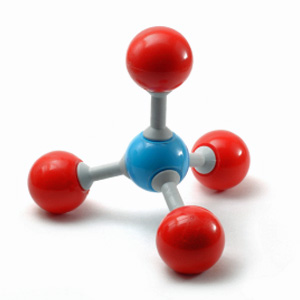
|
Using Integers to Explore Molecules |
||||||||
|
|||||||||
 |

Mathematics Skill or Topic Area:
Integer Arithmetic
Next Gen Science Standards PS1: Matter and Its Interactions; LS1: From Molecules to Organisms: Structures and Processes
Common Core ELA for Science: RST.6-8.2. Determine the central ideas or conclusions of a text; provide an accurate summary of the text distinct from prior knowledge or opinions. RST.6-8.8. Distinguish among facts, reasoned judgment based on research findings, and speculation in a text. RST.6-8.9. Compare and contrast the information gained from experiments, simulations, video, or multimedia sources with that gained from reading a text on the same topic.
Common Core Math Standard: CC.7.EE.3 Solve multi-step real-life problems posed with positive and negative rational numbers in any form (whole numbers, fractions or decimals) using tools strategically.

Video Engagement: Methane: An indicator for life? See how scientists are using spectroscopy to identify methane plumes on Mars. Learn about the biological and geological processes that form methane on Earth and the implications for astrobiologists who are looking for life beyond Earth. (7 minutes).View Program
|
Engage your students with a press release: Martian Methane Reveals the Red Planet is Not a Dead Planet Mars today is a world of cold and lonely deserts, apparently without life of any kind, at least on the surface. Worse still, it looks like Mars has been cold and dry for billions of years, with an atmosphere so thin, any liquid water on the surface quickly boils away while the sun's ultraviolet radiation scorches the ground.
But there is evidence of a warmer and wetter past -- features resembling dry riverbeds and minerals that form in the presence of water indicate water once flowed through Martian sands. Since liquid water is required for all known forms of life, scientists wonder if life could have risen on Mars, and if it did, what became of it as the Martian climate changed.
New research reveals there is hope for Mars yet. The first definitive detection of methane in the atmosphere of Mars indicates the planet is still alive, in either a biologic or geologic sense, according to a team of NASA and university scientists.
"Methane is quickly destroyed in the Martian atmosphere in a variety of ways, so our discovery of substantial plumes of methane in the northern hemisphere of Mars in 2003 indicates some ongoing process is releasing the gas," said Dr. Michael Mumma of NASA's Goddard Space Flight Center in Greenbelt, Md. "At northern mid-summer, methane is released at a rate comparable to that of the massive hydrocarbon seep at Coal Oil Point in Santa Barbara, Calif."
If microscopic Martian life is producing the methane, it likely resides far below the surface, where it's still warm enough for liquid water to exist. Liquid water, as well as energy sources and a supply of carbon, are necessary for all known forms of life.
It will take future missions, like NASA's Mars Science Laboratory, to discover the origin of the Martian methane. One way to tell if life is the source of the gas is by measuring isotope ratios. Isotopes are heavier versions of an element; for example, deuterium is a heavier version of hydrogen. In molecules that contain hydrogen, like water and methane, the rare deuterium occasionally replaces a hydrogen atom. Since life prefers to use the lighter isotopes, if the methane has
less deuterium than the water released with it on Mars, it's a sign that life is producing the methane.
Press release date line - January 15, 2009 Press release
location: [
Click Here ] |
|
Explore math connections with
SpaceMath@NASA
Problem I - Counting Atoms in Molecules - Students count the number of hydrogen, carbon and oxygen atoms in a single molecule of Propanol, and calculate the percentage of hydrogen atoms in the molecule. Topics include integer math and working with percentages. [Open PDF]
Problem II - Molecules - How Sweet They Are! - A simple counting activity is based on atoms in a sugar molecule. Students calculate ratios and percentages of various atomic types in the molecule. Topics include integer counting and working with ratios and percentages. [Open PDF]
Explain your thinking:
Write your own problem - Using information found in the Math Connection problems, the press release or the video program, create your own math problem that involves atoms and molecules and solve it. Explain why you set the problem up this way, and how you might find its answer.
Evaluate your understanding:
Challenge Problem - A maltose sugar molecule has 12 carbon atoms, 22 hydrogen atoms and 11 oxygen atoms. A single molecule of tannic acid has 64 more carbon atoms, 30 more hydrogen atoms and 35 more oxygen atoms than a molecule of maltose. How many methane molecules could you form from one tannic acid molecule if a single molecule of methane has one carbon atom and four hydrogen atoms? Explain how you arrived at this answer.
Answer: The molecule maltose has 22 hydrogen atoms, 11 oxygen atoms and 12 carbon atoms.
Tannic acid has (11+35)=46 oxygen atoms, (22+30)=52 hydrogen atoms, and (12+64)=76 carbon atoms so the maltose molecule has 76 carbon atoms, 52 hydrogen atoms and 46 oxygen atoms.
Methane requires four hydrogen atoms for every one carbon atom, so the most molecules of methane you could extract from a tannic acid molecule is 13 since 4 x 13 = 52 hydrogen atoms which is the
maximum you have in one tannic acid molecule.

NASA / JPL
3-D Solar System
Extend your new knowledge - Use the orbit of the Mars Science Laboratory to determine how often the MSL orbiter will be directly over head of the MSL rover as it searches for methane on the surface of mars. [ Open PDF ]